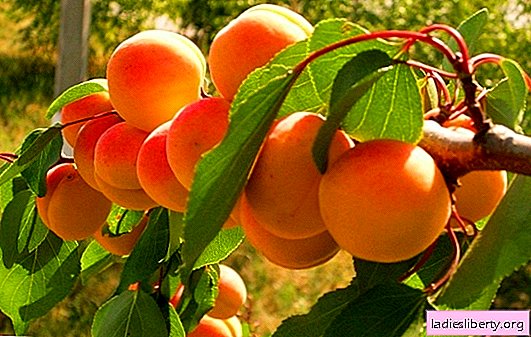
Apricots are heat-loving plants, so their cultivation in Russia has been problematic for some time. However, today breeders have bred a lot of resistant and unpretentious varieties, including the "Triumph North". This apricot is adapted for difficult climatic conditions, which allows it to be successfully cultivated in the central and northern parts of the country.
The history of selection of apricot "Triumph North", the characteristics of the variety and description
The variety was obtained at the University of Fruit Growing of Peter I by breeder A. Venyaminov as a result of crossing two varieties: the Red-cheeked apricot and the Northern one. The resultant variety is equally well adapted to heat and frost. The tree painlessly tolerates a drop in temperature to -33 ° C, sharp frosts, temperature drops and a long winter.

The tree is tall, with good care reaches a height of about 4 m. The shoots are powerful, the crown is spreading, wide. Fruiting begins 4 years after planting. A young tree gives up to 5 kg of fruit. With age, the yield increases, with at least 60 kg of apricots collected. In one place, the variety bears fruit for more than 25 years. However, the crops are unstable, fruiting occurs in a year. The flowering is plentiful, superearly.
Among the advantages of the variety, high disease resistance and self-fertility can be distinguished. The tree does not require cross-pollination.
Characterization of apricot fruit "Triumph North" and the purpose of the variety
The fruits of this variety are medium in size, their mass does not exceed 50 g. The color of the apricot is pleasant, yellow-orange with a red blush. The pulp is juicy, bright orange in color, sweet in taste, without fibers. The skin is slightly pubescent, of medium density, but tolerates transportation well. The kernels of this apricot are edible, have a characteristic almond taste and aroma.

Variety of universal purpose, fruits are suitable for summer consumption, processing, drying. To do this, they are collected at the stage of full maturity. If the crop requires transportation, it is better to collect the fruits unripe. Apricot ripening occurs in the second half of summer, starting in late July and lasting until August. The fruits are well kept on the tree, do not crumble, do not suffer from strong winds.
Features of planting varieties and selection of apricot seedlings "Triumph North"
Apricot seedlings are best purchased in a proven nursery of the area where the tree will be grown. They are more adapted and take root in a new place faster. When choosing a plant, it is better to give preference to seedlings with a closed root system. If there are none, then carefully inspect the roots, they should not be dry and lifeless.
Only previously prepared seedlings are transported. To do this, the root system is wrapped with a wet cloth and packaged in a bag. Planting is carried out in the spring, but experienced gardeners recommend purchasing trees in the fall and dig them in the garden until planting. In their opinion, such seedlings take root faster and bear fruit better.
Landing is carried out in late April or early May. The place is chosen based on the requirements of the variety. It should be calm and well lit. It is better to place the tree on the south side of the site. The soil for growing apricots should be fertile, loose, with a low occurrence of groundwater.

A pit for landing is prepared in advance, but not less than two weeks in advance. The size of the pit is 70 x 60 cm. The bottom is well drained; support for the seedling is established. During planting, it is important not to deepen the apricot root neck, but to leave it on the soil surface. If this is not done, then the tree will develop poorly and may rot.
How to grow Apricot Triumph North from seed
You can get good Triumph North apricot seedlings from the seed. Trees grown in this way develop better, since they are completely zoned to the conditions of detention. The process of growing seedlings is long, but not at all complicated.
1. Select some of the ripest fruits, separate the pulp from the seeds.
2. Soak the bones in warm water or a solution of growth stimulant for two days.
3. Place the planting material in a container of wet moss or sand. Create greenhouse conditions, but remember to ventilate.
4. Wait until the bones hatch and sprouts appear. Transplant them to the garden.
The bones are pecked for a long time, about 2-3 months, so they need to be germinated in advance. Transfer to the garden in early May.

Young seedlings are carefully looked after. They are transferred to a permanent place at the age of 1-2 years.
Caring for Apricot Seedlings
Immediately after planting, the plant is watered abundantly. So that the moisture is completely absorbed by the roots, a rim of earth is formed around the trunk. The soil is well mulched, which helps to maintain the necessary moisture. In the future, young seedlings are watered regularly, especially in the dry period. In the fall, the amount of water is reduced to prepare the tree for winter.
Adult specimens that are already bearing fruit are watered somewhat differently. In spring and summer, the soil is kept moist, but two weeks before harvesting, watering is stopped. During this time, apricots will gain sweetness, become juicy and large.
Top dressing
For better growth and development, seedlings are periodically fed. In the first year, fertilizers are not applied if, during planting, the pit was filled with fertile soil. From the second year of cultivation, nitrogen and phosphorus-potassium mixtures are used. Fertilize several times a season, in the fall all feeding is stopped, and the soil is mulched with a thick layer of humus.
Nitrogen is applied three times:
· Before flowering;
· After flowering;
· After falling off the extra ovary.
For 1 square. m. area is enough 300 grams of nutrient. Top dressing is done with a liquid solution or granules. It depends on the weather. If it rains, then it is better to introduce granules. In dry weather, it is more advisable to feed with an aqueous solution.
Potash mixtures and phosphorus are added during the fruiting period. The rate is calculated from the consumption per 1 square. m. area of 50-60 g of substance.
Winter preparations
Despite the good winter hardiness of the variety, young Triumph North apricots need reliable protection from the cold.
When the leaves are completely circled, all plant debris is collected and burned, and the soil is well loosened. This will help get rid of pests and pathogens. Trunks of trees are tied to supports, covered with spruce branches or other natural material. In this form, apricots winter.
Pruning
Apricots need proper pruning. In spring and autumn, they carry out sanitary cleaning, remove all old or broken shoots, dry branches, and then form a crown. Lateral shoots slightly shorten. All sections are treated with garden var. Spring pruning is done before the sap flow begins, and autumn pruning is planned after the end of the growing season.

Apricot variety "Triumph North" is considered the best for regions with a cold climate. The tree bears fruit well, does not require special care and propagates easily. The fruits have a pleasant taste, suitable for preservation, drying and fresh consumption.











